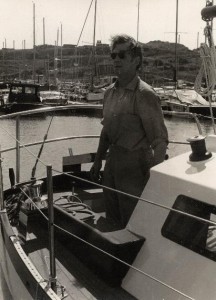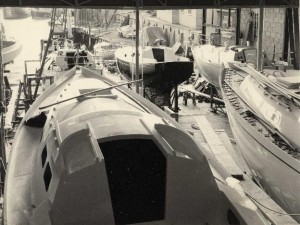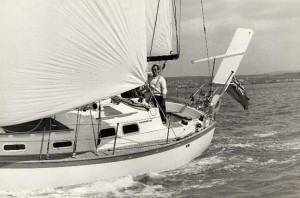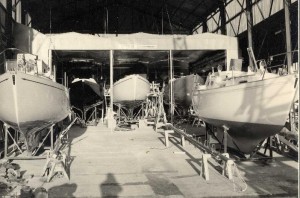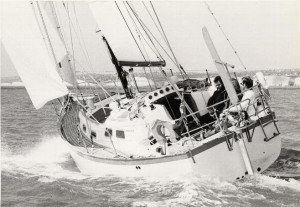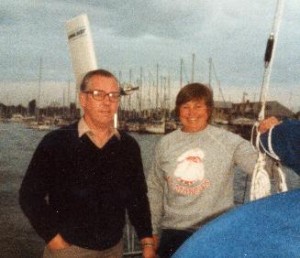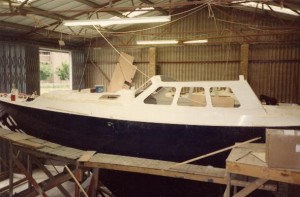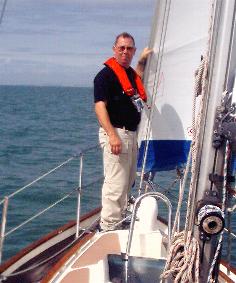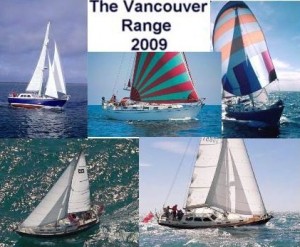Pheon Yachts
“The Ultimate Cruising Yacht”
and
“A Yachting Legend”
Together, the Vancouver 27 and Vancouver 32 can be described as, nothing less than icons in the yachting world. Both vessels, from the drawing board of the same designer – Robert B Harris of Canada – are yachts that have stood the test of time, truly deserving the accolade so often bestowed upon them of being …….
“THE ULTIMATE CRUISING YACHTS”
Many of these beautiful yachts are still sailing far and wide, some after more than thirty years. Though sadly no longer built by the original builder – Pheon Yachts Ltd – the Vancouvers are still built today, by Northshore Yachts, the company who have always supplied the moulded hulls.
The chemistry that came together to create the birth of these yachts, itself provides a story. It was in the early sixties that a family man, living in Sevenoaks and earning his living from what would now be described as “The Recycling Trade”, set about building in his back garden a 19ft gaff rigged bilge keeler. There was no other reason in his mind at this time, other than for his own family to enjoy sailing in their own boat. She was named “Pheon”, later to be known affectionately by the family as “Little Pheon“. Who knows, but this may well have been the initial spark, which in 1972, encouraged this man, John Dandridge, together with his wife Peggy, to set up a business near Newhaven, building yachts.
John Dandridge
The company was called “Pheon Yachts Ltd” after their much loved “Little Pheon”. From the very beginning the company was built by grit and determination to see the job through, a facet demonstrated by the whole family throughout the company’s existence. There had to be an enclosed unit to start building, so an old scout hut was demolished, and the salvaged materials used to erect a large shed, in a quarry at South Heighton. The plan was to build custom built “Hurleys”, the shed being large enough to accommodate the “Hurley 38”
The very first yacht fitted out, a “Hurley 24” could so easily have seen the demise of the company, for no sooner had it been completed than the Hurley company went into liquidation. Pheon Yachts was commencing business during a great growth period in the yachting industry, yet ironically at one of the most difficult, economically – who can forget the power strikes and three day weeks of the early seventies! Undeterred, John looked for an alternative design and soon commenced work on a 20ft Vagrant, building it as a cold moulded, one-off yacht.
It was during the construction of the Vagrant that John Dandridge demonstrated amazing insight. He read in a magazine about a yacht, designed by a Canadian designer – Robert B Harris – for a couple, who wanted to sail from their home in Seattle, to New Zealand. The criteria demanded by the couple, it had to be small enough to be easily handled, yet tough enough to take anything that could be thrown at it. The design was called ‘The Vancouver 27‘. All John knew about the yacht was what he saw before him, a magazine write up and a small side outline line drawing of the hull and rig, yet instinctively, his canny sense for recognizing a winner came to the fore, his heart jumped as he shouted, probably to the alarm of the rest of the family, “That’s the boat for me”. He immediately knew, this was the boat he wanted to build, so contacted the designer requesting permission to build one in Britain. I wonder if like John, Bob also recognised a winner, for no sooner had the request been made, than Pheon Yachts Ltd were granted the rights to build for all Europe. Stopping work on the Vagrant, John immediately threw himself into building a cold moulded Vancouver 27 in the shed at South Heighton, at the same time advertising it in Yachting World. The response was immediate and very quickly Vancouver 01, later to be named “Strider” was being built for a Dutch client.
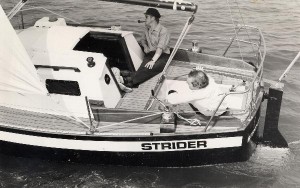 John with cap and pipe aboard “Strider”
John with cap and pipe aboard “Strider”
The interest that was being aroused in this new yacht was immense, and it soon became very clear that wooden one-offs were not going to work. The future lay in GRP. “Strider’s” launch coincided with the completion of the plug for GRP construction, but whilst she sailed beautifully she was found to be a little too tender and had a tendency to roll a bit too much. Bob Harris, who had flown over to see the new plug, on being told of the problem with “Strider”, suggested adding three inches to the beam at the waterline to make her stiffer. The advice came in the nick of time. The plug was altered, using quite a few buckets full of P38 car body filler, the result, the distinctive and much loved sea hugging tumblehome, found only on UK built Vancouvers.
Whilst John and Peggy were busy setting up the business, in the wings was another person who was to greatly contribute to the Vancouver’s success, their son Andrew. John was a perfectionist. When he built a yacht, it was extremely strongly constructed and functional, but unfortunately he did not have the eye for internal design. The reaction to the new Vancouver 27 had been beyond belief, everyone commenting on how superb a yacht she was, but there were reservations about her looks down below. She tended to be rather dark, heavy looking and old fashioned. Whilst many traditionalists might see this a virtue, it must be remembered that we were entering an era, where the new generation of yacht buyers were becoming more discerning, interior design, being as important to them as the sailing qualities. During the initial years of Pheon Yacht’s, Andrew was studying for a degree in ‘Three Dimensional Design’ at Brighton University – or as it was then, Polytechnic.
It was the summer of 1976, having obtained his degree and left Brighton, that Andrew joined his Mother and Father in the business, and was deemed to play an important roll, providing the final vital link. Before he did however he had a job to do for the company, which proved extremely useful to him. Vancouver 02 already named “Sunrise”, together with her new owner, needed to be delivered to Denmark. She was bright scarlet red in colour and looked stunning. It was a marvellous opportunity for Andrew, not only to really test and get the feel of the yacht, but also to monitor peoples reactions to her. Wherever “Sunrise” went she caught peoples eye and the comments could not be more favourable, but Andrew definitely at times detected a lesser response to her interior. At this time Vancouver 03, “Trinity”, was already under construction. When Andrew returned home from Denmark and joined the business, he was able to persuade his Father to let him use his new learnt skills, and look at the internal design of the yachts.
Andrew approached his roll by successfully combining his Father’s love of solid, with his own flair for style. This turned out to be a winning combination earning Vancouvers, and indeed Pheon, much acclaim. With the increasing demand for the yachts, Andrew also recognized the need for ‘production’ building as opposed to a series of ‘one-offs’. He saw this as an evolution process, with new ideas being introduced piecemeal in successive yachts, ideas often formed as a result of customer’s requirements. The full team was now in place, and it was working well.
THE VANCOUVER PHENOMINA WAS ON ITS WAY!
Under construction two deep in Old Cantells Shed
So great had been the interest towards, what was now quickly becoming a virtual icon in small yachts, that it became obvious during the build of “Trinity”, the demand had outgrown the shed at South Heighton. After procuring larger sheds on the slipway at Cantell’s Shipyard in Newhaven, all building was transferred there, the South Heighton shed being retained as a GRP component moulding shop. The company was expanding to meet demand. The new premises at Cantell’s permitted three 27s to be built at the same time. There were three building bays, each with a Chief Chippie in charge, whilst teams moved from boat to boat carrying out the construction process. At this stage three yachts in the shop were under construction, one lay outside undergoing final completion and another empty hull sat waiting to be moved in. It was going really well with one Vancouver a week being launched …. THEN ….
Crash! The government raised the rate of VAT to 17.5 %, orders dried up overnight.
It was an extremely hard time for Pheon Yachts Ltd whilst the effects of the new VAT rate were being accepted. It would have been easy to call it a day at that stage but the Dandridge’s belief in what they were producing and the sheer grit and determination to see it through rose to the fore. Sure enough, the new rate finally became accepted and the economy started again to pick up and orders eventually started rolling in again.
Andrew at the helm of Vancouver 32 No. 1
It was felt there was a niche in the market for a bigger sister to the 27, so in 1978/9, Bob Harris drew up the lines for the 32. Both yachts were to go on the market side by side. The first 32 built, John had scheduled to be exhibited at the London Boat Show in 1980. It was built in foam sandwich on frames at South Heighton. A mould was taken from her and shipped over to Northshore Yachts in Chichester who carried out all Pheon’s hull mouldings. The deck plug mould was to be built at South Heighton whilst the fit out was to take place in an extra bay which had been brought into use at at Cantell’s. Andrew was given total freedom to design the interior layout. It was a really exciting time with much hope for the 32 design ….. THEN ……..once again disaster struck! So much time, effort and money had been spent on the design of the deck plug which had incorporated many refinements and lessons learned from the 27. It had been shipped to Northshore for a mould to be taken when the unbelievable happened. The mould stuck fast to the plug. The report from Northshore’s Managing Director was – TOTAL LOSS!!
John, Peggy and Andrew Dandridge’s determination was once again being put to the test. John could not, indeed would not, accept defeat. For three solid weeks, everyone from Pheon worked to remove the plug from the mould. It had to be taken away piece by piece, delaminating the plywood layer by layer, whilst using solvents to clean back to the mould surface, and dissolving the paint layers off the mould. It was a heartbreaking, backbreaking and mammoth task, but the future of Pheon Yachts was at risk by the disaster, none of them were going to give in to that without a fight.
Production line building in the New Cantells Shed
Eventually they succeeded, but the delay caused, could well have meant missing the Boat Show deadline. The whole of the Pheon workforce worked day and night in order to make it, the last of the work on her, being complete as she was being manoeuvred through the doors of Earl’s Court on the back of a transporter. The 32 just like the 27 before it engendered tremendous response from both the yachting press and the yachting fraternity at large. Now with two models in high demand, Pheon moved into purpose built premises at the Cantell’s site. This provided five bays, all backing on to a mezzanine joinery workshop with stores beneath, three offices and a mess room. The work force had grown and now totaled up to twenty chippie, fitters and engineers. Vancouvers were starting to be frequently spotted, recognized and admired, all around the world. The legend was quickly being formed.
Vancouver 32 (01) under test for Practical Boat Owner by the late Geoff Pack. Geoff gave the 32 a glowing report.
In 1980 Andrew redesigned the interiors of both models which were to incorporate what became known as the “Three Bar Moulding” and is the method used on all Vancouvers to this day. The first yacht to be constructed with this design was “Sula Sula” which was to become Pheon’s new demonstrator, the previous one named “Pheon” having been sold. Shortly after her launch, “Sula Sula” took part in the Yachting World One of a Kind Rally, crewed by John, Peggy and an old sailing friend and ardent 27 advocate and owner, Bryce Valentine (see anecdotes below re Bryce). “Sula Sula” stole the show winning the rally outright in every category, with a full write up in “Yachting World”.
By this time there were no doubts in the minds of John, Peggy and Andrew, they were producing a legend, but they never sat back on their laurels. They were always looking to make improvements that would keep the Vancouver name in the forefront of yachting. In addition to the 27, the 27F (standing for family) was produced which eventually made way to the V274. The first of these, having been purchased by an American customer, was shipped out and exhibited at the Annapolis Boat Show.
John at the Annapolis Boat Show
A one off, really powerful Vancouver 38 was built but because of the construction limitations, she was built in steel. The finished yacht however gave every appearance of being GRP and looked magnificent. The last heard of her was when she was shipped over to Florida.
The Vancouver 32 Pilot under construction
Another variation was the Vancouver 32 Pilot. This proved not to be as popular as was hoped. The first built, ”Hoodwink”, is still however with its original owner in Eastbourne. Sadly, it was this model which started the final chapter of Pheon Yachts Ltd. A GRP version was commissioned by a customer from the US. The result was a superb yacht, but, due to the extensive modifications, in addition to the plugs and mouldings, costings were crippling at a particularly difficult time for the yachting industry, it all but broke the company. This was the eighties and no doubt the demise of many boat builders will be recalled, Westerly and Newbridge to name but two.
Being in need of urgent refinancing to continue, an enthusiastic owner, Kevin Seymor bought the company. John and Peggy took retirement whilst Andrew stayed with Pheon to continue production of what yachting journalists were voting, the best cruising yachts, the Vancouver27 and the Vancouver 32. Changes continued to be made and the Vancouver 27 became the Vancouver 28, the mark being called “The Vancouver Islander”. The first built was indeed named Islander and eventually was bought by Kevin himself. Sadly, as Islander was being completed, external financial problems hit the company with the result that in April 1986, Pheon Yachts Ltd went into receivership. The assets were bought by Brian Moffat’s Northshore Yachts. Andrew Dandridge went with the Vancouvers to the yard in Itchenor, where the yachts are being built to this day, still to the design drawn up by Andrew in 1986, however shortly afterwards he left Northshore to develop a businesses totally unconnected with boat building. Kevin Seymour was a few years later to join Northshore.
It was the end of an era but a legend had been born and continues to this day. Interestingly Andrew sailed a Vancouver 27 for several years, until recently when he sold her, after renovating to a most amazing standard what was – when he bought her – a very tired 32. Of course, both were named “Pheon” could they have been called anything else?. Kevin still sails a 32 called “Islander II”.
(Readers may well find interest in Andrew Dandridge’s yachting web site http://www.andrewdandridge.co.uk/pheon/ . They might in addition enjoy discovering more talents of this remarkable man on the following web site:- www.andrewdandridge.co.uk/ . If that is not enough, I would also mention that Andrew, together with his son, daughter and brother Brian form quite a band, try:- http://www.youtube.com/watch?v=czsoKPA5H1g . Quite a family.)
Andrew sailing his Vancouver 27
Andrew’s Vancouver 27, sailing in convoy with his new Vancouver 32 on one of the last sails made before the 27 was sold
Few people can lay claim to being party to a legend in their time. The Vancouvers certainly are a legend and still very much with us. But would they be so without John, Peggy and Andrew? Nobody could possibly know the answer for sure, but I have my doubts. True it was a fantastic design, which another builder might have seized upon, but, in my mind, the Dandridges are as much a part of the legend as the Vancouvers themselves. John not only had the insight to recognize a winner when he saw one, but he also possessed great skills and strength of character. Peggy, apparently Peggy could give you chapter and verse on every yacht built, as well as the people who bought them. A yacht is a very special purchase and Peggy understanding that, made it a very special occassion for all their customers. Andrew brought to the business a modern thinking. Having been trained in design, he had the knowledge and flair to provide the new, without loosing the merits of the old and he was able to produce these with modern production line methods. All three devoted fifteen years of their lives to build not just fantastic yachts but
“THE VANCOUVER LEGEND”
Sadly John and Peggy are no longer with us, and Andrew is no longer building yachts, having left Northshore in 1987, to join an architectural firm in London. There is however still a reminder of the Dandridges connection with Vancouvers every time a new one is ordered at Northshore. I do not believe any visitor to Northshore could fail to be impressed by the main offices and reception area, a truly fantastic building … built and fitted out to Andrew Dandridge’s design.
There is no doubt, the Vancouvers are still in good hands being built by Northshore, who have an excellent reputation for building fine craft. Yet, mention the word “Vancouver” to any enlightened yacht enthusiast, and you will hear the same question, “Was she Pheon built?” Safe as the future of the design might be, Vancouver and Pheon are synonymous, hence, even today, more than twenty years after the company went into receivership, the Vancouver Associations pennant is still, the Pheon logo emblem.
The Vancouver Association Burgee
Top left to right – V34 Pilot, V36, V28, Bottom left to right – V34, V38
Finally, a few anecdotes which epitomize the Vancouver Legend
1. Customer’s view of the original Cantell’s slipway shed
One customer, a Dutch gentleman of huge stature, making a comment on seeing the ramshackle shed,
“Such beautiful yachts come out of a mess of a shed like this?”
2. Bryce Valentine, John’s and Peggy’s sailing friend
Bryce, a keen Vancouver 27 owner, and always ecstatic about his yacht. Once whilst sailing in really bad weather in the Bay of Biscay, his yacht dropped off a wave clear out of the water. She then buried herself in the next wave rolling, through 360 degrees. In Bryce’s own words,
“She just came back up, shook herself like a wet dog, then carried on sailing!”
3. Ranked only with the best
During the construction of “Trinity”, Pheon Yachts was visited by a gentleman whose name was Martin Barr. Many might know him for being lead guitarist of the rock band “Jethro Tull”. He placed an order for a 27 to be named “Sossity”. Andrew, got to know Martin well and often looked after “Sossity” whilst the band was on tour. Later “Sossity” was featured in a glowing article by Yacht and Boat Owner in 1978. A quote from that article ….
“As with the Vancouver 27, or a Rolls Royce, anything at the top of its market is a fail-safe investment”!
4. The 1980 London Boat Show
During the exhibition, three gentlemen in smart suits came on board and spent much time looking over the whole yacht. Finally when about to leave, they turned to John Dandridge and declared.
“We are from Nautor, we build the Swan. We give you second prize as we must take the first!”
5. The ultimate test for the “Ultimate Yacht”
In addition to his design and production roll with Pheon Yachts, Andrew was Chief Demonstrator. In many cases he operated single handed, as most customers were unfamiliar with the boat, and many even with sailing. This was a demanding task, having to keep his potential owners informed, answer their questions and sail the boat in a manner that would show its qualities.
On one occasion, an elderly couple had travelled a long way for their demonstration sail of a 32. On their arrival, the wind was howling so John said to them, “Well we are game if you are”. They were up for it and the demo took place, starting with a reef in the main and the No. 2 genoa. As they left the narrows and entered the main harbour the noise was deafening, with waves crashing against the outer harbour arm and sending spray a hundred feet high. Andrew thought it prudent to reef further, taking in another in the main and reducing to the No 3 genoa. They set off again past, the lighthouse at the end of the main harbour arm. Once clear of the shelter, the wind dial shot round to a constant 54 knots. The yacht rose up on the huge rolling swell from the south west, but she didn’t flinch. She rode the winds and waves as if born to it. Andrew, describing the demo afterwards said,
“We could not believe just how steady she was in the face of such an onslaught – WHAT A BOAT!”
“The Ultimate Cruising Yacht”
and
“A Yachting Legend”
Pete Wheeldon
Pete wishes to sincerely thank Andrew Dandridge for supplying details and photographs which have made this narrative possible. He also wishes to thank Andrew for reading through the proof and agreeing to the publishing of the article on this web site.


